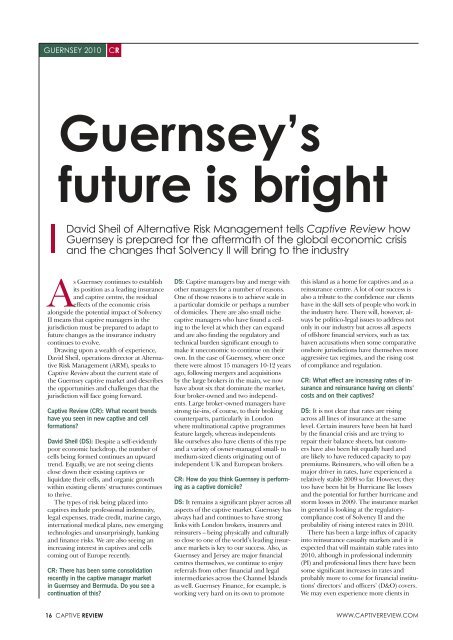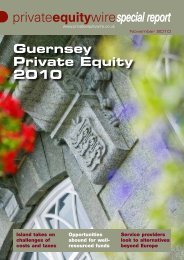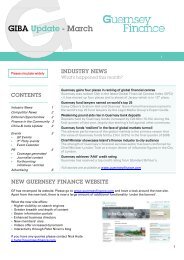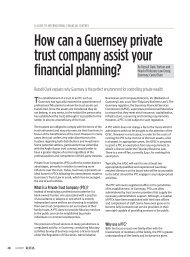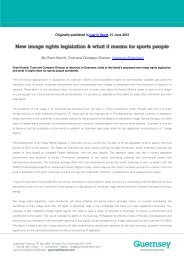Link - Guernsey
Link - Guernsey
Link - Guernsey
- No tags were found...
Create successful ePaper yourself
Turn your PDF publications into a flip-book with our unique Google optimized e-Paper software.
GUERNSEY 2010CR<strong>Guernsey</strong>’sfuture is brightDavid Sheil of Alternative Risk Management tells Captive Review how<strong>Guernsey</strong> is prepared for the aftermath of the global economic crisisand the changes that Solvency II will bring to the industryAs <strong>Guernsey</strong> continues to establishits position as a leading insuranceand captive centre, the residualeffects of the economic crisisalongside the potential impact of SolvencyII means that captive managers in thejurisdiction must be prepared to adapt tofuture changes as the insurance industrycontinues to evolve.Drawing upon a wealth of experience,David Sheil, operations director at AlternativeRisk Management (ARM), speaks toCaptive Review about the current state ofthe <strong>Guernsey</strong> captive market and describesthe opportunities and challenges that thejurisdiction will face going forward.Captive Review (CR): What recent trendshave you seen in new captive and cellformations?David Sheil (DS): Despite a self-evidentlypoor economic backdrop, the number ofcells being formed continues an upwardtrend. Equally, we are not seeing clientsclose down their existing captives orliquidate their cells, and organic growthwithin existing clients’ structures continuesto thrive.The types of risk being placed intocaptives include professional indemnity,legal expenses, trade credit, marine cargo,international medical plans, new emergingtechnologies and unsurprisingly, bankingand finance risks. We are also seeing anincreasing interest in captives and cellscoming out of Europe recently.CR: There has been some consolidationrecently in the captive manager marketin <strong>Guernsey</strong> and Bermuda. Do you see acontinuation of this?DS: Captive managers buy and merge withother managers for a number of reasons.One of those reasons is to achieve scale ina particular domicile or perhaps a numberof domiciles. There are also small nichecaptive managers who have found a ceilingto the level at which they can expandand are also finding the regulatory andtechnical burden significant enough tomake it uneconomic to continue on theirown. In the case of <strong>Guernsey</strong>, where oncethere were almost 15 managers 10-12 yearsago, following mergers and acquisitionsby the large brokers in the main, we nowhave about six that dominate the market,four broker-owned and two independents.Large broker-owned managers havestrong tie-ins, of course, to their brokingcounterparts, particularly in Londonwhere multinational captive programmesfeature largely, whereas independentslike ourselves also have clients of this typeand a variety of owner-managed small- tomedium-sized clients originating out ofindependent UK and European brokers.CR: How do you think <strong>Guernsey</strong> is performingas a captive domicile?DS: It remains a significant player across allaspects of the captive market. <strong>Guernsey</strong> hasalways had and continues to have stronglinks with London brokers, insurers andreinsurers – being physically and culturallyso close to one of the world’s leading insurancemarkets is key to our success. Also, as<strong>Guernsey</strong> and Jersey are major financialcentres themselves, we continue to enjoyreferrals from other financial and legalintermediaries across the Channel Islandsas well. <strong>Guernsey</strong> Finance, for example, isworking very hard on its own to promotethis island as a home for captives and as areinsurance centre. A lot of our success isalso a tribute to the confidence our clientshave in the skill sets of people who work inthe industry here. There will, however, alwaysbe politico-legal issues to address notonly in our industry but across all aspectsof offshore financial services, such as taxhaven accusations when some comparativeonshore jurisdictions have themselves moreaggressive tax regimes, and the rising costof compliance and regulation.CR: What effect are increasing rates of insuranceand reinsurance having on clients’costs and on their captives?DS: It is not clear that rates are risingacross all lines of insurance at the samelevel. Certain insurers have been hit hardby the financial crisis and are trying torepair their balance sheets, but customershave also been hit equally hard andare likely to have reduced capacity to paypremiums. Reinsurers, who will often be amajor driver in rates, have experienced arelatively stable 2009 so far. However, theytoo have been hit by Hurricane Ike lossesand the potential for further hurricane andstorm losses in 2009. The insurance marketin general is looking at the regulatorycompliancecost of Solvency II and theprobability of rising interest rates in 2010.There has been a large influx of capacityinto reinsurance casualty markets and it isexpected that will maintain stable rates into2010, although in professional indemnity(PI) and professional lines there have beensome significant increases in rates andprobably more to come for financial institutions’directors’ and officers’ (D&O) covers.We may even experience more clients in16 Captive review www.captivereview.com


